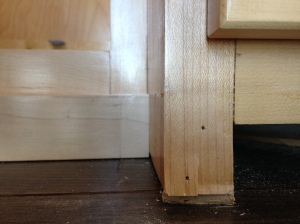
There are companies out there who really show themselves as a class act by not bad-mouthing their competitors. Integro is not one of those companies. I thought we would be – after this past week, I have changed my mind. We’re currently working at The Grant Project and have just finished spending 40 hours cleaning up after and documenting a shady general contractor’s work and I just heard a horror story from a colleague who has asked for my help to take over for a family with two little kids who are currently in the middle of a dying gut renovation. It’s guys like these contractors that make us all look bad. Let me also point out that these guys were not cheap and had dozens of 5-star online reviews. These people have now spent a huge amount of money for work that has simply not been done.
So, from me to you folks, here are some tips on what a good contractor should be doing:
1. Be Present. The general contractor (GC) should show up – often. Unless there is an extenuating circumstance such as Zoning or Building Department delays, you should have things happening every week if not every day. Trades should be showing up so that the GC can…
2. Maintain a Schedule. Your initial contract should include a schedule. Let me repeat that: Your initial contract should include a schedule. Okay, Integro has aggressive schedules with detailed breakdowns – it doesn’t have to be this fancy. A start date and substantial completion are the bare minimum. You need some kind of benchmark as to how the project is progressing in the event that your GC does not…
3. Communicate Often. Let’s define Often, shall we? The bare minimum is once per week – there should be things happening that warrants bragging about, right? Also, Often is whenever there is something that warrants discussing. Things that warrant discussing include anything that affects you personally or changes your final product from previously agreed upon. During these meetings, your GC should also…
4. Be Friendly. GCs are notorious for bad attitudes. Don’t take that cop out. It’s a defense mechanism and they shouldn’t have anything to be that defensive about. GCs should be able to communicate in a productive manner about anything because they know how to…
5. Scope the Work. I will preface this advice with the caveat that GC’s are NOT trades, they are managers of the trades. This is much harder. Your GC probably doesn’t know how to do the calculation for the furance load on your 2nd floor – your GC should be able to explain why we need a furance calculation done to determine the load. Make sense? If your GC is issuing change orders, then the Scope of Work should be clear and they should be able to explain it. Make them explain it. Just casually ask them to go through what needs to happen to get from your request to the end result. It should be easy for them if they’ve already given you a price. An honest price is easy to figure out when they…
6. Know Their Limitations. Sebastian is awesome – truly, awe inspiring sometimes. Just when I think we’re about to hit a crunch, things are magically done and he’s having an apple outside. Having said that, we’re able to pull through on projects because we understand exactly what we DON’T do with our own two hands and we’re up front about it. Do we build custom millwork? Absolutely! We just don’t do it house – we work with the experts to make it happen. The biggest disaster items at The Grant were “custom millwork” pieces that the GC supposedly did in his “shop”. Let’s take a look at these “custom” items:
(drawer cabinet built too tight so horizontal pieces are bowed, stopping the ‘soft-close’ drawers from opening and closing)
(veneer on ‘solid wood’ cabinet cracked because a framing nail was used instead of a finishing nail and the application is poor)
(hint: screws should not be showing – screws should not be the size of a large insect)
(millwork should not be finished with baseboard trim anymore than it should be connected with deck screws…yes, deck screws)
(generally speaking, a 1/4″ difference between identical cabinets being installed adjacent to each other in the same space is poor craftsmanship)
The only thing high-end about these pieces are the prices.
Is a GC telling you that they do custom millwork in-house? Great! Ask for a tour of their shop. Seeing their shop will also give you an idea of how well they…
7. Clean. As someone once put it, we are “cuckoo about cleaning…” I’ll admit, Integro has a bit of a complex. What can I say? We’re aiming high. Cleaning sets a tone on site. GCs who think to clean up after themselves are thinking about the big picture. It’s that simple. Mistakes happen when everything is everywhere primarily because once one person lowers the level of respect for a property, the rest will quickly follow. Here’s are some examples of what can happen when crews aren’t expected to care:
(brand new flooring)
Construction can be challenging. Specifically, gut renovations have a remarkably consistent emotional schedule. You shouldn’t expect your GC to be perfect or for every day of construction to be happy. You should expect your GC to have integrity, give you confidence, be available, and provide you with a final product.
If you are doing a project where you think you might have a shady GC on board. STOP. Get a home inspection. Call your lawyer. Don’t cut any more checks until you’ve confirmed that you’re on track.
(this was what we found after we opened up the ceiling for a wine cooler – no comment)











OMG! Those pictures document a one way ticket on the construction crazy train. Wow. I just. Wow.
LikeLike
Yeah, it was hard to come up with words
LikeLike